Recent reports of panic buying and empty supermarket shelves make rationing and the Dig for Victory campaign undeniably topical amid the Covid 19 Pandemic.
But unlike today where the United Kingdom is approximately 61% self-sufficient in all food, prior to the start of World War Two Britain imported most of its food.*1.
Introduction of food rationing during World War Two

Before World War Two Britain imported about 55 million tonnes of food by ship a year from all over the world. After war was declared, the government had to cut down on the amount of imported food due to attacks on supply ships and cargo ships being used for war materials rather than food transportation. It was feared that this would lead to food shortages, price increases and people ultimately being unable to afford to eat. There was also a danger that some might hoard food, leaving none for others. The government introduced a system of rationing in stages from January 1940, which ensured that people received an equal amount of food each week. Butter, sugar, tea, jam, cheese, eggs and meat were amongst the items strictly rationed and queuing for these became common place.
Ration Books
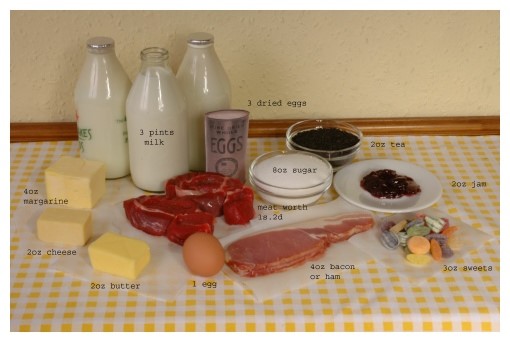
Eighty years ago, everyone had ration books with coupons inside that could be exchanged for food at certain shops. Three different coloured ration books were issued, and their colours ensured that the right amount and types of food that was needed was given the right person. Most adults had buff coloured books. Pregnant women, nursing mothers and children under the age of five had green ration books. Blue ration books were for children aged 5-16 years who also had fruit, the full meat ration and half a pint of milk a day.

Ministry of Food
At the end of World War One much of Britain had been left undernourished despite the introduction of rationing in 1918. During World War Two the government appointed Lord Woolton as the Minister of Food (1940 – 1943). Woolton’s job was to prevent the U.K. going hungry which he tackled by both promoting the benefits of rationing and educating people about better eating habits. The Ministry of Food started publishing Food Facts pamphlets in 1940 and produced recipes, posters and radio programmes such as The Kitchen Front and the Radio Doctor. They gave guidance about rationing schemes, encouraging the use of foods which were more generally available and discouraging food waste.
Woolton Pie
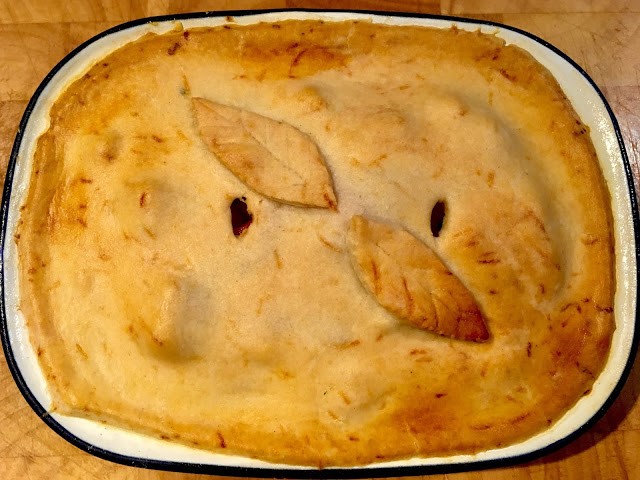
Woolton’s familiarity may be because of the wartime vegetable pie that was named after him. The Woolton Pie recipe, publicised by the Ministry of Food, was created by François Latry, the French‐born chef of the Savoy Hotel. The pie was created as a dish that housewives could recreate at home despite rationing.
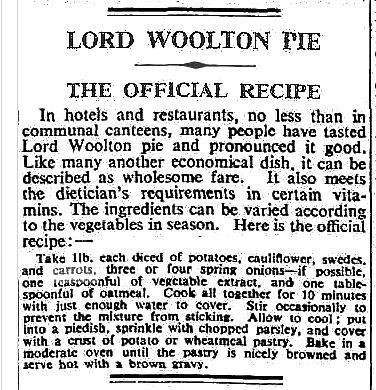
The Kitchen Front
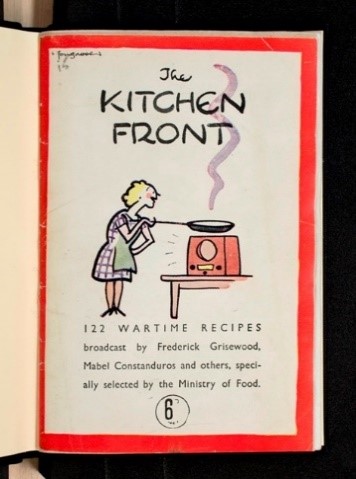
During World War Two 5 – 7 million people regularly listened to a BBC radio cookery programme called The Kitchen Front. It was at 8:15am each morning and the programme aimed to boost morale using humour and characters who were familiar.
Dig for Victory
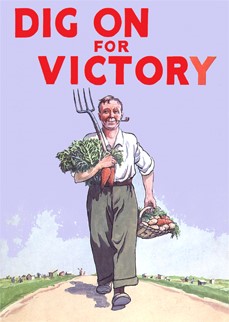
The Dig for Victory campaign was launched in October 1939, and people were urged to become self-sufficient by using every spare piece of land to grow vegetables. Hundreds of young people headed to Harvest Camps to volunteer for a week or more working outside harvesting vegetables or flax. The well-stocked Victory Garden became a symbol of resilience. Victory Gardens were a way for those at home to feel like they were part of the war effort by providing practical support for rationing. The ability to grow your own vegetables, fruit and herbs was important for both health and well-being.
We want not only the big man with the plough but the little man with the spade to get busy this autumn. Let ‘Dig for Victory’ be the motto of everyone with a garden, Rob Hudson, Minister for Agriculture, October 1939.
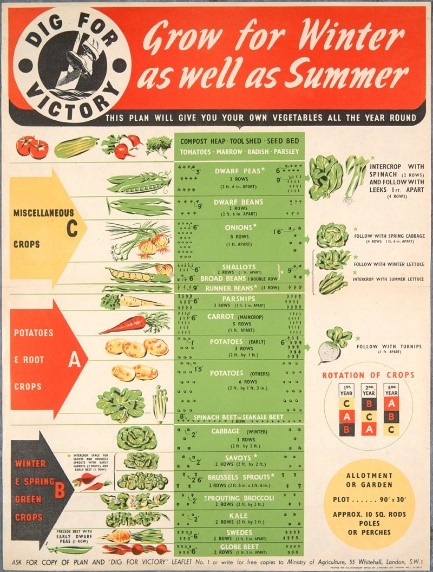
There were regular radio broadcasts on growing your own, and the Ministry of Food issued posters and leaflets on subjects including making a compost heap, sowing seeds and crop rotation. The vegetables that people grew during the war years were largely the same as ones grown today. The range and availability of seeds was occasionally limited, however. Onions were dried and strung up. Peas could be gathered, dried and cooked months later to make pease pudding or mushy peas. Leeks, cabbages, cauliflowers and sprouts were best stored in the ground until needed. In 1943 the number of allotments reached an all-time high of 1.4 million.
Cecil Henry Middleton – Gardening Celebrity
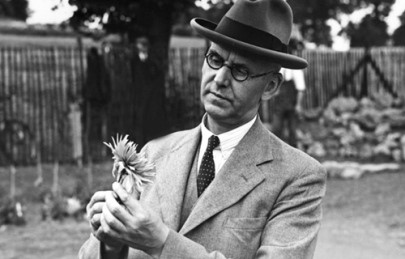
Affectionately known as Mr. Middleton, Cecil was a writer and one of the earliest radio and television broadcasters about gardening for the BBC. By 1940, 3.5 million listeners tuned in to hear Mr. Middleton’s 15 minute talks on Sunday at 2:15pm. His In Your Garden talkswere so popular that they were also published as books.
Potato Pete and Doctor Carrot
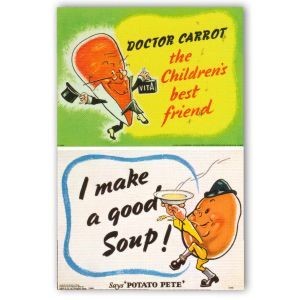
Vegetables became a staple after meat was rationed. They were both easy to grow and abundant. Carrots and potatoes became the focus of a campaign to get people, especially children, to enjoy vegetables. They even had their own cartoon characters, Potato Pete and Doctor Carrot, and songs. The Food Advice Division travelled all over Britain and set up demonstrations in markets, shops, factories, canteens and welfare clinics to provide support on the Home Front. Potato Pete and Doctor Carrot appeared in most recipes. Carrots were promoted as a substitute for scarcer vegetables, meat and as a sweetener in desserts in the absence of sugar. They were also used in jams, spreads and drinks. Housewives prepared treats such as carrot biscuits, carrot marmalade and carrot juice drinks! A propaganda campaign told families that carrots helped people to see in the dark, and that the British pilot’s victories were courtesy of their improved eyesight from eating so many! Although factually inaccurate, this did encourage people to eagerly tuck into carrots.
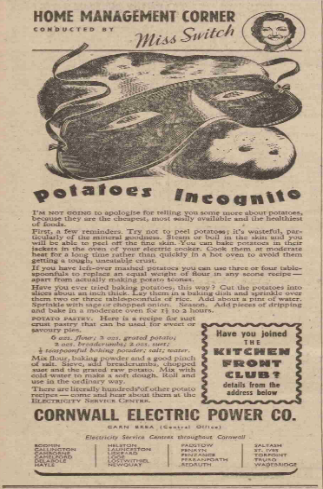
The Cornishman, April 1941
Preserving and Food Waste

Pickling onions, bottling fruit, preserving tomatoes, drying and salting were all promoted. Leaflets aimed to encourage people to preserve food when available for use in the winter. Housewives were also advised to make chutneys and pickles to make food taste better. Apple peel was boiled to make a lemon substitute in jams or drinks; bacon rinds provided fats for cooking meat or were used for flavouring soups; stale bread went into puddings or to make stuffing. Other scraps fed animals like chickens and pigs. Leaflets like What’s left in the larder helped ensure that nothing was wasted.
Changed eating habits
Food shortages had a big impact on cooking as recipes had to be adapted and new ones created to cook with ingredients that were available. People became used to dried milk and eggs. The Ministry of Food obtained Spam, dried eggs and dried milk in large quantities from the USA. The egg powder was not especially popular however as it made rubbery omelettes and puddings! The wartime diet was low in fats and sugars and high in fibre and vegetables. People who had previously had a poor diet increased their intake of protein and vitamins as a result of rationing. Infant mortality rates decreased and there was an increase in the average life span.*2.
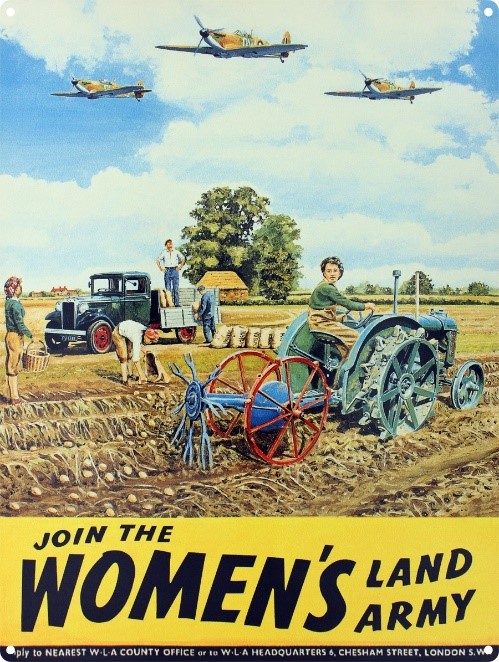
Lend a hand on the land
At a time that the government wanted to increase the amount of food grown in Britain there was a labour shortage on farms and in other jobs on the land. The Women’s Land Army (WLA) was set up in 1917 but disbanded at the end of the First World War. The WLA reformed in June 1939 and looked for physically fit, young, unmarried women with no dependents who were willing to be sent anywhere in the country. Reasons for joining the Woman’s Land Army were varied and included an opportunity for independence and the uniform as breeches could be worn unlike other service uniform. Women in the WLA, who were often known as land girls, looked after animals, ploughed fields, harvested crops and killed rats amongst many other tasks. In 1944 there were more than 80 000 women in the Women’s Land Army.
References
- House of Commons Library, Food Security: What is it and how is it measured?https://commonslibrary.parliament.uk/science/environment/food-security-what-is-it-and-how-is-it-measured/
- British Nutrition Foundation
Further viewing, listening and reading
- Potato Pete song. Sung by actress Betty Driver, best known as Betty Turpin, barmaid in the Rover’s Return on Coronation Street.
- Women’s Land Army – Mickey’s Story of the Women’s Land Army in Cornwall
- Imperial War Museum – What was the Women’s Land Army?
- Bodmin Keep – Rationing blog
- Imperial War Museum – Appeal to grow vegetables from the Ministry of Agriculture
- Dig for Victory WW11 Homefront Growing and Food
- BBC News in Pictures, Digging for Victory: Stories from wartime gardens
- British Pathe – Pictorial personalities: In your garden, 1944 – Cecil Henry Middleton
- Retro recipes – 10 Thrifty wartime dishes
By Deborah Vosper and Jo Keenan
